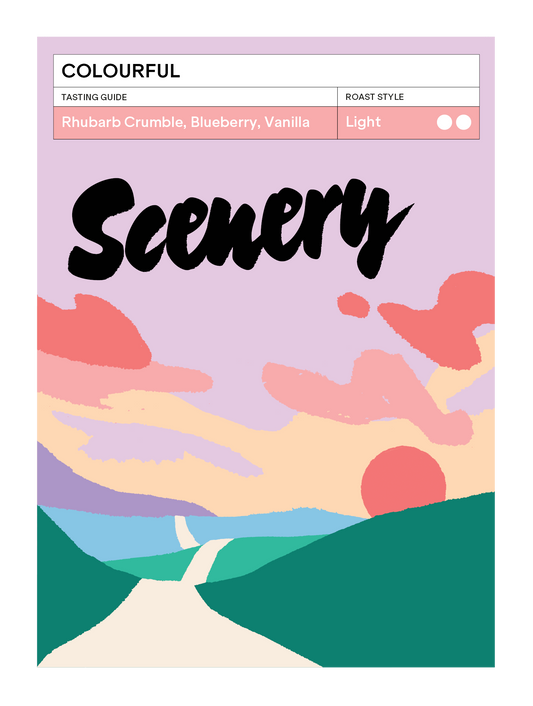This easy drinking field blend from the Mazateca region of Mexico ran from 10/01/2024 to 22/05/2024.
In the Sierra Mazateca region of Oaxaca, Mexico, small-scale coffee producers face low yields and challenges of under-development, yet produce high-quality coffees.
A novel approach by Raw Material and Red Beetle involves re-processing discarded beans from colour sorters in dry mills, separating quality beans that would have otherwise been sold at sub-commercial prices on the internal market. The result is surprisingly tasty! And even better yet, returns speciality grade pricing to the producers where it has maximum impact.
Brew Guide:
Best Brewed with: Filter
Roasted with a touch more development without overt roaster influence, we’re looking for a syrupy, soluble filter with heaps of body.
Try a 62g/L ratio when making filter, a slight updose more when brewing immersion, and touch more yield when making espresso (We like 18g in, 40g out, 30-34s to ensure acidity is balanced)
We’re tasting: Sweet chocolate, dried fruit (raisins & dates) and a weighty body. There's some soft spiced caramel notes reminiscent of darker grade maple syrup, and an acidity that reminds us of candied peel. There's a hint of bramble jam in the finish, without tartness.
Traceability:
Country of Origin: |
Mexico |
Region: |
Sierra Mazateca, Oaxaca |
Producers: |
Pequeños productores de la Sierra Mazateca |
Variety: |
Typica, Mundo Novo, Bourbon |
Elevation: |
1200-2000 MASL |
Process: |
Washed - field blend. |
Import Partner: |
Raw Material |
Harvest |
23/24 - Arrived UK: Dec 23 |
The Story
The Mazateca region, located in Oaxaca, Mexico, is known for its cultural and biological diversity. Home to the indigenous Mazatec people, it's a mountainous area characterised by mesophile forests, constant rain, and mist. Despite a rich indigenous heritage, the long term effects of a history of colonialism in Central America has left the region facing significant challenges in under-development.
A key feature of the Mazateca is its tradition of coffee growing. The terrain's steepness makes farming difficult, but it contributes to the high quality of coffee produced. However, for a long time, these unique coffees were lost in large regional/commercial blends. By cupping small lots individually, various qualities and flavour profiles are identified, improving the economic return of value for local producers.
The region struggles with low coffee prices, coffee leaf rust, and ageing plants, leading to low yields and an increase in migration, especially among the young. This leaves the labour-intensive coffee work to older producers. The main coffee varieties are Typica, Mundo Novo, and Caturra, often over 40 years old and un-pruned/un-stumped, contributing to low yields.
The average coffee producer in the Mazateca owns less than a hectare, leading to small-scale production. Owing to the conditions in the field, the majority of yields for these farmers are incredibly low - even as small as below a single sack of exportable green coffee.
For contrast, a recent lot we picked up for Facility Blend saw a Guatemalan smallholder produce over 1300kg (20 x 69kg) of green coffee from a 0.7HA plot, a 10 fold difference. The region's remoteness and challenging conditions have led to it being neglected, even within the coffee industry. Despite this, the Mazateca produces some of the most complex and high-quality coffees in Mexico, once the effort is made to cup, separate nano-lots, and produce smaller scale focused field blends
Efforts are being made to integrate Mazateca producers into the specialty coffee market, aiming to create a sustainable and profitable supply chain. This initiative seeks to improve yields, volumes, and quality of coffee production in the region, offering a viable alternative to selling to local intermediaries at market prices. One crucial step in the final export process is running the milled coffee through an optical colour-sorter.
This machine uses tiny cameras and puffs of compressed air to remove any out-of-spec green beans - physical defects, foreign matter - at a tremendous rate, replacing the work of hand-sorting through individual lots before bagging. But, to quote an old legend of my coffee youth - “there are many more ugly beans than there are defects”. When it comes to the small scale yields, the discard pile from the colour sorter can represent a significant fraction of a producer’s work. Traditionally, this coffee is sold on the internal market for a fraction of the price achieved for the speciality export-grade lot.
Raw Material, on a mission to maximise producer income - alongside export partner Red Beetle coffee - have come up with a pretty ingenious method where the discard pile from the colour sorter (containing the defective beans we don’t want, ugly beans we don’t mind, and erroneously rejected good beans) is run through the machinery again on a tighter tolerance - rejecting the vast majority, but separating out that which shouldn’t have been removed in the first place.
The result is surprisingly tasty! And even better yet, returns speciality grade pricing to the producers where it has maximum impact.

![[17] Mexico - Electrónicas Mazateca [CROP 23/24 ARCHIVE]](http://scenery.coffee/cdn/shop/articles/mexico_electronicas_shopify_1.png?v=1718266533&width=1100)
![Colombia - Quebraditas Ají Thermal Shock Washed [FESTIVE SPECIAL] 🎄](http://scenery.coffee/cdn/shop/files/colombia_quebraditas_aji_shopify.png?v=1764358600&width=533)






![Colombia - Quebraditas Sidra Thermal Shock Washed [25/26]](http://scenery.coffee/cdn/shop/files/colombia_quebraditas_sidra_2526_shopify.png?v=1765544630&width=533)



![Colombia - Luz Ángela's Chiroso [25/26]](http://scenery.coffee/cdn/shop/files/colombia_luz_angela_chiroso_2526_shopify.png?v=1764359755&width=533)


![Colombia - El Jaragual Rosado [25/26]](http://scenery.coffee/cdn/shop/files/el_jaragual_rosado_2526.png?v=1757075842&width=533)